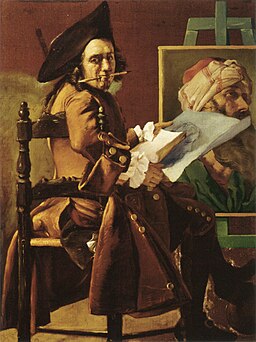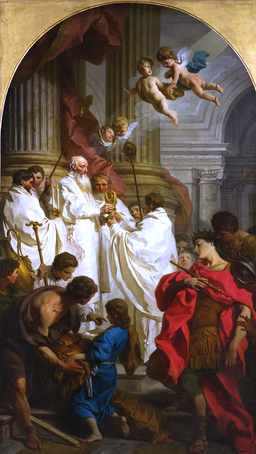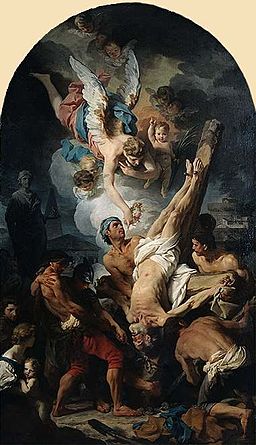
L'Atelier du peintre, ca.1740
Born November 25, 1699 in Southern France, Pierre Subleyras was a late-Baroque painter. At the age of 29 he won a scholarship to study in Rome and remained there for the rest of his life painting mainly alterpieces and portraiture. Subleyras had a unique eye for composition, color and figure arrangement, along with an astute sense of perception and presence in his portraits that is distinctively his own. One can see the heavy Italian influence yet there is also a clear French pride in his work, and most often he is an eclectic blend of the two, which makes him very interesting to study as a truly underrated and brilliant painter who had an amazing range.
In the painting above in his studio, we see a self-reflexivity that is almost Post-Modern, showing himself painting some of his most famous works as if some kind of greatest hits album cover or something. He is poking fun of himself as an artist carelessly mass-producing work as if in a factory with a spotless tiled floor. To the right he also depicts himself looking at us holding a self-portrait as a younger man. This charming work shows how prolific an artist of that period had to be, and how little time he may have had for other things in life.
In his Self-portrait below discovered in 1968 on the reverse of the studio painting above, he seems to look over at us with a modern demeanour, as if posing for the camera. I like the way his drawing stylus is crammed between his teeth. In his hands he holds some drawings, and on his easel is a painting of a bearded man. Subleyras seems to be telling us he sees himself as no different than any other profession and that his craft is just as much a trade as a skilled cobbler or architect.

Self-portrait, ca.1746

The Mass of Saint Basil, 1746
Click here for zoomable version
This stunning alterpiece reveals Subleyras' talent for figure arrangement and creating a sense of space within the canvas he works in—a vertical one in this case—as well as a keen depiction of facial expression. The body language he utilizes here is so expressive it is musical, yet Subleyras' use of alternating design is how he achieves it. Note how the four figures on the bottom left are spaced apart with faces downcast or looking away from us, compared with the figures on the right which are visually compressed due to perspective, and with faces looking in our general direction except for the fifth character on the edge of the painting with the helmet.The six figures in white are composed in pairs that alternate both in height and age, with the left and right figures depicting the bearded men below the youths, while the center figures show the elder standing above the bearded man. Look at the cool shadows in the white robes. The architecture helps to heighten the sense of space while framing the figures, and the cherubs in a diagonal shaft of light. Subleyras uses color, texture, light, and figure arrangement to create a masterpiece that can be observed endlessly.

The Mystic Marriage of St. Catherine of Ricci, 1745
Subleyras's depiction of Saint Catherine as being a devoted nun given a ring by Jesus. Note her crown of thorns. Another brilliant example of figure arrangement, this painting is filled with triangles, with the most important one being between Christ, Catherine and Mary. What is also interesting here is the arrangement of the cherubs, with the foreground three at their feet, with the far right cherub standing with a bouquet of flowers. Subleyras' use of light is dramatic here, with the light behind Christ glowing while darkness looms behind Catherine and the figures behind her. A haunting painting with naturally graceful figures and a muted palette. Subleyras gives special attention to white as holy and pure, and the way he paints white is unlike any artist I have seen.

Portrait of Benedict XIV, 1746
This curious portrait of the pope, eyes looking away lost in thought, is one of the most informal portraits ever painted of the pontiff. Examine his face up close, however, and a real man appears before your eyes under the vibrant brushstrokes of Subleyras. His papal ornate stole revealing the papal coat of arms, appears to shimmer under the light falling from the right. A man who had a very busy papacy and at times stressful, Benedict XIV was known as a person of good cheer and jovial, a rarity for a person of such eminence and responsibility.

Crucifixion of Saint Peter, late 1700's
A truly remarkable work, Subleyras focuses on the physicality of St. Peter being crucified upside down by five men, who appear to be struggling with the task. An angel with cherubs from heaven descends immediately, moved by St. Peter's humility and foreshadows the importance of his future legacy in the Church. Note the very dark sky behind them. Exactly how Subleyras would have conceived of such a composition and arranged these individual figures is mindboggling because of the natural strain and body language they have. Note how his color accents focus our attention on the main figures, while the key figure, St. Peter, is of course in white. Subleyras creates a sense of movement and physical labor within the drama of the most important religious figure in the Roman Catholic Church after Christ.

Christ at the House of Simon the Pharisee, ca. 1737
This astonishing work takes the spirit and scale of a Veronese with a sombre earth-toned palette and a Baroque sensibility full of movement and shadows. It amazes me that despite the horizontal composition and minimal background detail, Subleyras uses figure arrangement to lead the eye around the painting without resorting to elaborate costumes. Instead, he uses chiaroscuro and depth to create his sense of space. Note how Christ is off-center to the left, without halo or holy glow, yet his body language is so arresting our eye leads directly to him. Here his feet are being annointed by a sinner woman, presumably Mary Magdalene. Every single person in this painting is doing something, and Subleyras realized it would be more realistic and interesting to not include the faces or bodies of every person. Looking from left to right, we can see how Subleyras' musicality appears once again with the figures changing in space arrangement from wide apart to tightly compressed, each figure looking in a different direction:

Visual rhythm, chiaroscuro, anatomy, body language and facial expression while using color to accent: this is the ingredients of a masterpiece that Subleyras made to look effortless, yet is incredibly well-thought out and executed. Subleyras had an understanding of composition that has so much to teach us, and his visual poetry is symphonic. The past has plenty to teach us, and artists of today who don't learn from it only delude themselves. Merci, Subleyras. Merci.
Comments
Post a Comment